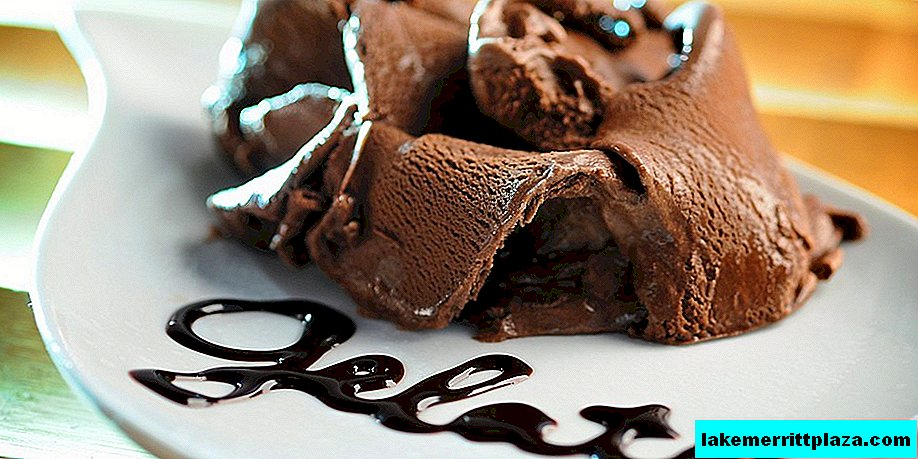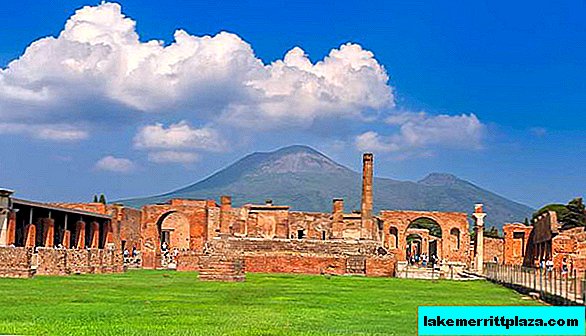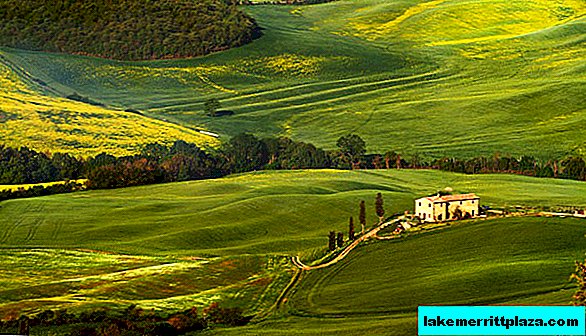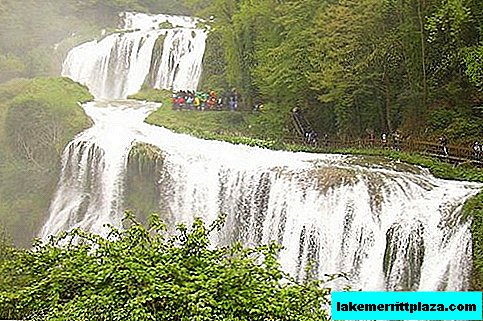He was shot more than once in cartoons and movies. This dessert is sung in the songs of performers from many countries of the world. And finally, people of the whole earth love him, young and old. All this, no doubt, can be said about only one delicacy called "Ice Cream". And if it is Gelato - Italian ice cream, then there will be no equal to it in any corner of the world. This is a pleasant coolness that saves in the summer heat, and a milk veil that complements a cup of coffee on a winter evening with family. Masters make real gelato by hand, giving it their unique zest.

Story
The history of gelato is so ancient that it is almost impossible to find when it was born. One thing can be said: his ancestors are significantly different from modern versions.
The first lovers of frozen desserts were Neanderthals, who lived about 35 thousand years ago. They hid berries and fruits in the snow to preserve them. Later nations learned how to freeze milk in the winter months.
In the future, the first fragrances appeared - honey, fruit and berry purees. Among the ancient Romans, ice cream made from ice covered with a decent layer of honey from the volcanoes Vesuvio and Etna was popular.
In the IX century, the Arabs living in Sicily (Sicilia), made ice cream from infusions of herbs and spices with sugar obtained from cane. Such a mixture was placed in a container surrounded by ice and salt, and a delicious sorbet was obtained for that time.
The great traditions of gelato were laid during the Renaissance in Italy (XIV-XVI centuries). The famous Medici family sponsored a culinary competition for the best frozen dessert. Farmer Ruggeri won the competition by making ice cream from sweet fruit juice and ice (similar to today's sorbet). The news of his talent quickly spread. Catherine de Medici (Caterina de Medici) even invited a skilled chef to her wedding with the future king of France. She was sure that only Ruggeri could compete with the French cooks. Although some historians believe that all this is nothing more than a beautiful legend.
In the late 1500s, the Medici family ordered the famous artist and architect Bernardo Buontalenti to prepare a beautiful celebration on the occasion of the arrival of the King of Spain. Using his culinary skills, the master met his majesty with a magnificent creamy frozen dessert. He prepared what we call gelato today. It Buontalenti is considered the inventor of Italian ice cream.

Francesco Procopio dei Coltelli made gelato famous throughout Europe. Moving from Palermo to Paris, he opened a cafe, which later became the center of innovation. They first started serving ice cream in small glasses. The institution was extremely successful and was the starting point of the trip gelato in Europe.
Gelato first came to America in 1770 when Giovanni Basiolo brought his recipe to New York. Then there were two types of ice cream: one made from water with fruits, and the other made from milk with cinnamon, coffee, pistachios, or chocolate. In 1846, freezers were improved, freezing occurred with constant stirring. So the Americans got a real gelato, which was no longer grainy, but had a pleasant creamy consistency.
The year 1884 is considered the year of the start of mass ice cream sales in Italy. With the advent of modern freezers, a new era of industrial cooking gelato has begun. But even today, the original and most delicious Italian ice cream is made by hand in special institutions - gelateria.
Ingredients
Did you know that all the ingredients for making gelato are probably already in your refrigerator? For Italian ice cream they take exclusively natural ingredients, which makes it not only tasty, but also very useful.
Milk and cream

The gelato base is chosen depending on which option they are going to cook. Water is the base for fruit sorbets; creamy versions are made with milk. The best flavor is whole milk ice cream, but some manufacturers use raw materials with low fat content (1-2%) or completely fat-free. Milk helps to get a smooth, creamy texture, and also increases the dessert's resistance to melting. Its content in gelato is about 60%. Often manufacturers add a little milk powder, but this is by no means a trick. Its lactose absorbs free water, and proteins give the mass a stable consistency. From 5 to 20% cream is added to the gelato to give the taste a brighter milk aroma and a delicate texture.
For people suffering from lactose intolerance, modern manufacturers produce gelato based on soy milk.
Sugar

Masters add sugar to gelato not only to make it sweet. This component helps lower freezing temperature and increase viscosity. There are many different types of sugars that differ in chemical composition:
- Sucrose (from reed);
- Lactose (from milk);
- Fructose (from fruit);
- Invert sugar from glucose, honey and corn syrup.
The original gelato uses cane sugar, the content of which is from 14 to 24%. It is worth noting that invert sugar is much sweeter than its counterparts. Therefore, when using it, the proportion of this ingredient in the dessert is markedly reduced.
Gelato manufacturers strive to keep up with the times and offer options for people with any dietary features. Some companies produce ice cream with a sugar substitute.
Flavors

Do not be afraid of this scaring word, as gelato aromatize exclusively with natural ingredients. Vanilla, coffee, chocolate, hazelnuts, pistachios are added to ice cream. Desserts with fruits (peach, lemon) and berries (raspberries, strawberries, blueberries, black currants) are very popular. They are added fresh, frozen or in the form of fruit puree.
In industrial versions, gelato can still use artificial flavors. So there are on sale versions with the taste of tiramisu, yogurt or exotic fruits.
Egg yolks, stabilizers and emulsifiers
Egg yolks give gelato a denser, more viscous consistency. If the manufacturer does not use them, then on completely legitimate grounds he can add stabilizers and emulsifiers (but naturally in minimal quantities). The former act as thickeners, the latter prevent delamination. Both of these components are derived from natural substances.
Air
Amazing but air is a very important component of gelato. Use it to whip ice cream. This increases the volume and smooths the texture. Before being fed into the mass, the air passes through many filters and comes in completely clean, so it does not affect the taste of the dessert.

How to make an original gelato
Previously, all stages of the preparation of gelato were carried out strictly by hand, but now some processes help the master to make special devices. Milk-based ice cream is prepared by the so-called hot method.
At the first stage, milk, sugar and additives (stabilizers and emulsifiers) are dosed and mixed. In Italy, the addition of flavoring ingredients occurs immediately before freezing.
This is followed by pasteurization of the mixture - heat treatment, which kills pathogenic microflora, but leaves all taste characteristics unchanged. The mass is heated to 82-85 degrees, constantly shaking, for 3 minutes, and then cooled to 4 degrees in freezers. At this temperature, the product ripens, which lasts 6-12 hours.
At the next stage, natural flavors are added, and the freezer switches to negative temperatures for a few minutes. In this case, the mass is constantly mixed, and air is supplied to obtain a characteristic consistency.
The resulting gelato is stored in a chamber at a temperature of -18 degreesto ensure the correct structure and safety of ice cream. Dessert is prepared in small portions with a variety of flavors in order to provide customers with a fresh gelateria product.
Calorie content and benefits

The calorie content of gelato directly depends on its ingredients. Non-dairy ice cream contains about 220 kcal per 100 g. If you prefer a dessert with additives, then you should know that each added component increases the energy value. For example, options with chocolate or nuts conceal more than 300 kcal per 100 g.
The least high-calorie are water-based fruit sorbets. They boast only 130 kcal per 100 g of product.
Gelato is an excellent dietary supplement for any healthy person. Dairy varieties are a source of protein, calcium, phosphorus and B vitamins. In addition, lactose in milk contributes to better absorption of calcium.

Ice cream with coffee or chocolate is a storehouse of antioxidants (polyphenols). They fight free radicals that cause aging processes in cells. Cocoa also contains vitamin E - the main assistant to the human reproductive system.
The benefits and vitamin set of fruit gelato are determined by the berries and fruits that make up the basis of the dessert. However, vitamin C is almost destroyed during the preparation process, so its activity in the product should not be taken into account.
Gelato is a great option for a snack, if breakfast has long passed, but before lunch is still not close. Scientists have proven that ice cream for the throat is a wonderful way to harden tonsils, like a cold shower for the whole body. It is recommended to use it in small quantities even in the cold season.
Varieties and their differences
Depending on the production method, gelato is divided into:
- Gelato artigianale (so-called homemade ice cream);
- Gelato industriale (industrial version).
Gelato artigianale is made in gelatories just before serving. The fat content in it is 6-10%. The proportion of air can reach a maximum of 35%. As a rule, all components are completely natural.
Gelato industriale has a longer shelf life. The fat content in it is from 8 to 12%. Italians call such ice cream “wind”, since the amount of air in it is such that it is at least 20% of the dessert volume (often the figures reach 40%). Manufacturers can use dyes, stabilizers and emulsifiers.
Italy is the only country in the world where ice cream covers 55% of the market. With the annual growing demand for dessert, the industrial production of gelato with cheaper ingredients is inevitable.

Depending on the ingredients used, gelato happens:
- Gelati al latte or milk ice cream;
- Gelati di frutta or fruit sorbet.
Recipe "Gelato Chocolato"
The famous hit of the 80s “Gelato chocolato” by Italian singer Pupo sharply increased the interest of our compatriots in this dessert. So, meet on the stage homemade chocolate ice cream. You will need:
- 250 g of fresh cream;
- 150 g of milk;
- 150 g of dark chocolate;
- 150 g of sugar;
- 3 egg yolks;
- A pinch of vanilla or vanilla essence.
Of the kitchen helpers you need: a pot with a thick bottom, a bowl for whipping yolks, a bowl for freezing and a mixer.
Cooking
In a thick-bottomed pan, melt the chocolate along with cream and milk. In a bowl, beat the egg yolks with sugar until the mass is light and uniform.
Pour the egg mixture into the pan. The fire should be minimal. Mix well and wait until the mass is very hot, but do not bring it to a boil to avoid coagulation of the yolks. Remove the container from the heat, add the vanillin and mix again.
Pour the gelato into a storage bowl and let it cool to room temperature. Then refrigerate it for several hours.
Remove the ice cream and beat with a mixer at minimum speed for 20 minutes. Turn off the appliance and please your beloved homemade gelato chocolatos to the fiery rhythms of the Italian song!
Gelato is appreciated and loved in many countries of the world. Italian gelatories, carefully preserving the traditions of ice cream, will be able to please you with an original dessert at any time of the year. Live boldly, love naturally, travel with benefit and remember: "The hunger of a wolf drives from the forest, and a person into gelateria!"








